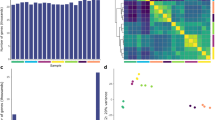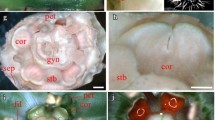Abstract
Development in dioecious cultivated spinach, Spinacia oleracea, is distinguished by the absence of alternative reproductive organ primordia in male and female flowers. Given the highly derived floral developmental program in spinach, we wished to characterize a spinach C class floral identity gene and to determine the patterns of sequence evolution as well as compare the spatial and temporal expression patterns with those of AGAMOUS. The isolated cDNA sequence clusters phylogenetically within the AGAMOUS/FARINELLI C class clade. In comparison with the SLM1 sequence from the related Silene latifolia, amino acid replacements are highly conservative and non-randomly distributed, being predominantly found in hinge regions or on exposed surfaces of helices. The spinach gene (SpAGAMOUS) appears to be exclusively expressed in reproductive tissues and not in vegetative organs. Initial expression of SpAGAMOUS is similar in male and female floral primordia. However, upon initiation of the first whorl organs, SpAGAMOUS becomes restricted to meristemic regions from which the reproductive primordia will develop. This results in an early gender-specific pattern. Thus, the spinach C class gene is differentially expressed prior to reproductive organ development and is, at least, correlated with, if not directly involved in, the sexual dimorphism in spinach.





Similar content being viewed by others
Abbreviations
- SpAGAMOUS :
-
Spinacia AGAMOUS
- SpAG :
-
SpAGAMOUS
- G-6pdh :
-
Glucose-6 phosphate dehydrogenase
- PCR:
-
Polymerase chain reaction
- RT-PCR:
-
Reverse transcription linked polymerase chain reaction
- 3′RACE:
-
Rapid amplification of 3′ cDNA ends
References
Ainsworth C, Crossley S, Buchanan Wollaston V, Thangavelu M, Parker J (1995) Male and female flowers of the dioecious plant sorrel show different patterns of MADS box gene expression. Plant Cell 7:1583–1598
Ambrose BA, Lerner DR, Ciceri P, Padilla CM, Yanofsky M, Schmidt RJ (2000) Molecular and genetic analysis of the Silky1 gene reveal conservation in floral organ specification between eudicots and monocots. Mol Cell 5:569–579
Baldi P, Brunak S, Frasconi P, Pollastri G, Soda G (1999) Exploiting the past and the future in protein secondary structure prediction. Bioinformatics 15:937–946
Barrier M, Robichaux RH, Purugganan MD (2001) From the cover: accelerated regulatory gene evolution in an adaptive radiation. Proc Natl Acad Sci USA 98:10208–10213
Baum DA, Doebley J, Irish VF, Kramer EM (2002) Response: Missing links: the genetic architecture of flower and floral diversification. Trends Plant Sci 7:31–34
Becker A, Theissen G (2003) The major clades of MADS-box genes and their role in the development and evolution of flowering plants. Mol Phylogenet Evol 29:464–489
Bradley D, Carpenter R, Sommer H, Hartley N, Coen E (1993) Complementary floral homeotic phenotypes result from opposite orientations of a transposon at the plena locus of Antirrhinum. Cell 72:85–95
Davies B, Motte P, Keck E, Saedler H, Sommer H, Schwarz-Sommer Z (1999) PLENA and FARINELLI: redundancy and regulatory interactions between two Antirrhinum MADS-box factors controlling flower development. Embo J 18:4023–4034
Doebley J, Lukens L (1998) Transcriptional regulators and the evolution of plant form. Plant Cell 10:1075–1082
Favaro R, Pinyopich A, Battaglia R, Kooiker M, Borghi L, Ditta G, Yanofsky MF, Kater MM, Colombo L (2003) MADS-box protein complexes control carpel and ovule development in Arabidopsis. Plant Cell 15:2603–2611
Felsenstein J (1993) PHYLIP (Phylogeny Inference Package) 3.5p. Department of Genetics, University of Washington, Seattle, WA
Grant S, Houben A, Vyskot B, Siroky J, Pan W-H, Macas J, Saedler H (1994) Genetics of sex determination in flowering plants. Dev Genet 15:214–230
Hardenack S, Ye D, Saedler H, Grant S (1994) Comparison of MADS box gene expression in developing male and female flowers of the dioecious plant white campion. Plant Cell 6:1775–1787
Irish VF (1999) Patterning the flower. Dev Biol 209:211–220
Irish VF (2003) The evolution of floral homeotic gene function. Bioessays 25:637–646
Irish VF, Kramer EM (1998) Genetic and molecular analysis of angiosperm flower development. Adv Bot Res 28:197–230
Jack T (2004) Molecular and genetic mechanisms of floral control. Plant Cell 16:S1–S17
Kanno A, Saeki H, Kameya T, Saedler H, Theissen G (2003) Heterotopic expression of class B floral homeotic genes supports a modified ABC model for tulip (Tulipa gesneriana). Plant Mol Biol 52:831–841
Kater MM, Colombo L, Franken J, Busscher M, Masiero S, Van_Lookeren_Campagne MM, Angenent GC (1998) Multiple AGAMOUS homologs from cucumber and petunia differ in their ability to induce reproductive organ fate. Plant Cell 10:171–182
Kitahara K, Matsumoto S (2000) Rose MADS-box genes ’MASAKO C1 and D1’ homologous to class C floral identity genes. Plant Sci 151:121–134
Kramer EM, Irish VF (1999) Evolution of genetic mechanisms controlling petal development. Nature 399:144–148
Kramer EM, Irish VF (2000) Evolution of the petal and stamen developmental programs: Evidence from comparative studies of the lower eudicots and basal angiosperms. Int J Plant Sci 161:S29-S40
Kramer EM, Jaramillo MA, Di Stilio VS (2004) Patterns of gene duplication and functional evolution during the diversification of the AGAMOUS subfamily of MADS box genes in angiosperms. Genetics 166:1011–1023
Kumar S, Tamura K, Jakobsen IB, Nei M (2001) MEGA2: Molecular Evolutionary Genetics Analysis software 2.1. Arizona State University, Tempe, Arizona, USA
Kyozuka J, Kobayashi T, Morita M, Shimamoto K (2000) Spatially and temporally regulated expression of rice MADS box genes with similarity to Arabidopsis class A, B and C genes. Plant Cell Physiol 41:710–718
Lamb RS, Irish VF (2003) Functional divergence within the APETALA3/PISTILLATA floral homeotic gene lineages. PNAS 100:6558–6563
Larget B, Simon D (1999) Markov chain Monte Carlo algorithms for the Bayesian analysis of phylogenetic trees. Mol Biol Evol 16:750–759
Lohmann JU, Weigel D (2002) Building beauty: the genetic control of floral patterning. Dev Cell 2:135–142
Lohmann JU, Hong RL, Hobe M, Busch MA, Parcy F, Simon R, Weigel D (2001) A molecular link between stem cell regulation and floral patterning in Arabidopsis. Cell 105:793–803
Mandel MA, Bowman JL, Kempin SA, Ma H, Meyerowitz EM, Yanofsky MF (1992) Manipulation of flower structure in transgenic tobacco. Cell 71:133–143
Pelaz S, Ditta GS, Baumann E, Wisman E, Yanofsky MF (2000) B and C floral organ identity functions require SEPALLATA MADS-box genes. Nature 405:200–203
Pfent C, Pobursky KJ, Sather DN, Golenberg EM (2005) Characterization of SpAPETALA3 and SpPISTILLATA, B class floral identity genes in Spinacia oleracea, and their relationship to sexual dimorphism. Dev Genes Evol. DOI:10.1007/s00427-004-0459-4
Pinyopich A, Ditta GS, Savidge B, Liljegren SJ, Baumann E, Wisman E, Yanofsky MF (2003) Assessing the redundancy of MADS-box genes during carpel and ovule development. Nature 424:85–88
Pobursky KJ (2000) Early flower development and the influence of gibberellic acid on sex expression in Spinacia oleracea. Wayne State University, Detroit
Purugganan MD, Boyles AL, Suddith JI (2000) Variation and selection at the CAULIFLOWER floral homeotic gene accompanying the evolution of domesticated Brassica oleracea. Genetics 155:855–862
Saedler H, Becker A, Winter KU, Kirchner C, Theissen G (2001) MADS-box genes are involved in floral development and evolution. Acta Biochim Pol 48:351–358
Samach A, Kohalmi SE, Motte P, Datla R, Haughn G (1997) Divergence of function and regulation of class B floral organ identity genes. Plant Cell 9:559–570
Schmidt RJ, Veit B, Mandel MA, Mena M, Hake S, Yanofsky MF (1993) Identification and molecular characterization of ZAG1, the maize homolog of the Arabidopsis floral homeotic gene AGAMOUS. Plant Cell 5:729–737
Schwarz-Sommer Z, Huijser P, Nacken W, Saedler H, Sommer H (1990) Genetic control of flower development by homeotic genes in Antirrhinum majus. Science 250:931–936
Soltis DE, Soltis PS, Albert VA, Oppenheimer DG, dePamphilis CW, Ma H, Frohlich MW, Thei[ss]en G (2002) Missing links: the genetic architecture of flower and floral diversification. Trends in Plant Science 7:22–31
Strimmer K, Haeseler Av (1996) Quartet puzzling:A quartet maximum likelihood method for reconstructing tree topologies. Mol Biol Evol 13:964–969
Swofford DL (1993) PAUP: phylogenetic analysis using parsimony 3.1. Illinois Natural History Survey, Champaign
Wang R-L, Stec A, Hey J, Lukens L, Doebley J (1999) The limits of selection during maize domestication. Nature 398:236–239
Yanofsky MF, Ma H, Bowman JL, Drews GN, Feldmann KA, Meyerowitz EM (1990) The protein encoded by the Arabidopsis homeotic gene agamous resembles transcription factors. Nature 346:35–39
Zik M, Irish VF (2003) Flower development: initiation, differentiation, and diversification. Annu Rev Cell Dev Biol 19:119–140
Acknowledgments
We are indebted to D. Carl Freeman (Wayne State University) for his introduction to and insight in the sexual dimorphism and lability of spinach. We thank John M. Lopes (Wayne State University) and Aleksandar Popadic (Wayne State University) for their insightful comments on a previous version of this manuscript.
Author information
Authors and Affiliations
Corresponding author
Electronic Supplementary Material
Rights and permissions
About this article
Cite this article
Sather, D.N., York, A., Pobursky, K.J. et al. Sequence evolution and sex-specific expression patterns of the C class floral identity gene, SpAGAMOUS, in dioecious Spinacia oleracea L. Planta 222, 284–292 (2005). https://doi.org/10.1007/s00425-005-1544-2
Received:
Accepted:
Published:
Issue Date:
DOI: https://doi.org/10.1007/s00425-005-1544-2




